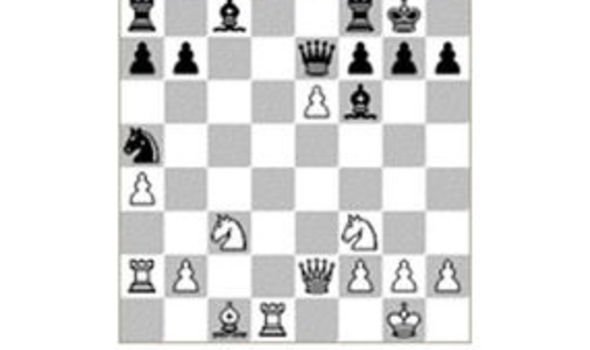CHESS - 24/10/10 Daily Express

Chess Diagram 1
Sunday October 24,2010
By Luke McShane
VLADIMIR Kramnik was the winner of the Grand Slam Masters Final event in Bilbao this month.
In the four player double round robin event, Kramnik beat Magnus Carlsen and Alexei Shirov, drawing his other four games.
He finished ahead of World Champion Vishy Anand, who scored his single win against Carlsen, drawing all five other games.
Magnus still seems to be struggling with his form after a bad performance at the Olympiad, although after a dismal start with two losses, he pulled back with a fascinating win against Shirov in the penultimate round.
He finished in third place ahead of Shirov who could only manage four draws and two losses to finish last.
The tournament used the “football” scoring system of three points for a win, one for a draw.
As it happened this made no difference to the final rankings had the conventional scoring method of one point for a win, half for a draw, been used instead.
In an interesting twist, Magnus Carlsen is in danger of losing his place as the World Number 1 rated player, as he has dropped sharply since the Olympiad, while Anand has nudged above the 2800 mark on the unofficial 'Live' rating lists which is updated in between the official Fide rating lists.
But both will be in action at the Pearl Spring Masters in China which will be well under way when this goes to press, so the top spot is still very much up for grabs.
Vladimir Kramnik - Alexei ShirovHe finished ahead of World Champion Vishy Anand, who scored his single win against Carlsen, drawing all five other games.
Magnus still seems to be struggling with his form after a bad performance at the Olympiad, although after a dismal start with two losses, he pulled back with a fascinating win against Shirov in the penultimate round.
He finished in third place ahead of Shirov who could only manage four draws and two losses to finish last.
The tournament used the “football” scoring system of three points for a win, one for a draw.
As it happened this made no difference to the final rankings had the conventional scoring method of one point for a win, half for a draw, been used instead.
In an interesting twist, Magnus Carlsen is in danger of losing his place as the World Number 1 rated player, as he has dropped sharply since the Olympiad, while Anand has nudged above the 2800 mark on the unofficial 'Live' rating lists which is updated in between the official Fide rating lists.
But both will be in action at the Pearl Spring Masters in China which will be well under way when this goes to press, so the top spot is still very much up for grabs.
(Bilbao, 2010)
1.d4 d5 2.c4 c6 3.Nf3 Nf6 4.Nc3 dxc4 5.a4 e6 5...Bf5 is the most common move, leading to a typical Slav defence. Shirov's move draws the position towards an IQP (isolated queen's pawn) structure, where Black hopes that the weaknesses left by the advance a2-a4 compensate for the loss of tempo in playing c7-c6-c5. 6.e3 c5 7.Bxc4 Nc6 8.0–0 Be7 9.Qe2 cxd4 10.Rd1 0–0 11.exd4 Nd5 12.Bb3 Na5?! The beginning of a faulty plan. White's light squared bishop is a crucial piece in this structure, as it can be used both to fight for the key d5 square and to develop an attack when switched to the b1–h7 diagonal. But Shirov's operation to remove it takes too much time and it turns out that the cure is worse than the disease. 13.Ba2 Perhaps Shirov's idea would have made more sense if the bishop retreated to c2 here. 13...Nb4?! 14.d5! Clearly the best move, taking the initiative while Black is undeveloped. I suppose Black was expecting 14.Bb1 Nb3 15.Ra3 Nxc1 16.Rxc1. 14...Nxa2 15.Rxa2 Bf6 16.dxe6 Qe7? (see diagram) 16...Qe8! was a much better fighting chance 17.exf7+ (17.Nd5 is a creative try, but after 17...Bxe6 18.Nxf6+ gxf6 19.Ra3 Bb3! Black has time to exchange queens) 17...Qxf7 18.Nd5 Be6 19.Nxf6+ Qxf6 20.Ra3 and Black has minimal compensation for the pawn. But the game is still complicated.
17.Nd5! Qxe6 18.b4! A neat use for the rook on a2. Kramnik is winning material by force here. 18...Nc6 18...Nb3 19.Be3 leaves the knight hopelessly stranded on b3. 19.b5 Ne5 20.Nc7 Nxf3+ 21.gxf3 Qxe2 21...Qf5!? was an interesting option, as it's natural to want to keep the queens on to drum up compensation for the exchange which Black will lose. After 22.Nxa8 Be6 23.Nc7 Bxa2 24.Qxa2 Qxf3 Black seems to have counterplay, but just a few accurate moves are required: 25.Qd5! Qg4+ 26.Kh1 Be5!? tricky, as the rook is loose on d1, but 27.b6! axb6 28.Nb5 Qxa4 29.Be3 and in this position three pawns are no match for the extra piece. 22.Rxe2 Be6 Perhaps Shirov hadn't realised that Kramnik would force an exchange of dark squared bishops immediately after, or he might have jettisoned the exchange in a different way. For example, 22...Rb8 23.Ba3 Bh3 24.Bxf8 Kxf8, although this is also very bad. 23.Nxa8 Rxa8 24.Bb2! Forcing the bishops off. 24...Rc8 24...Be7 25.Rxe6! fxe6 26.Rd7 Bf6 27.Bxf6 gxf6 28.Rxb7 is absolutely winning with Black's king pinned to the back rank. White will simply advance a pawn to the seventh rank and then give check (e.g. a4-a5-a6 and b5-b6 if Black does nothing). 25.Rc1 Rd8 26.Bxf6 gxf6 27.Kg2 The exchange of dark squared bishops makes the win straightforward as the rooks can't be hassled on the dark squares. 27...a6 28.bxa6 bxa6 29.Rc6 Kg7 30.Re4 f5 31.Rh4 Ra8 32.a5 Kg6 33.Kg3 Kg5 34.Rd4 h5 35.h4+ Kf6 36.Kf4 Rb8 37.Rxa6 Rb2 38.Ra4 Rxf2 39.Rxe6+! fxe6 40.a6 Re2 41.a7 1–0





No comments:
Post a Comment